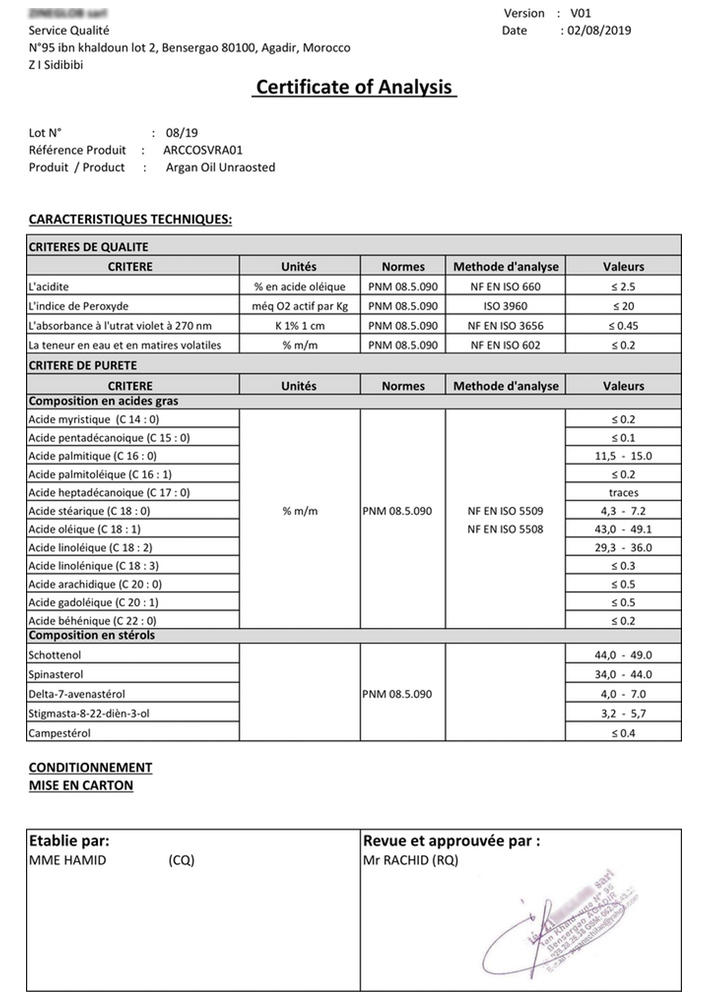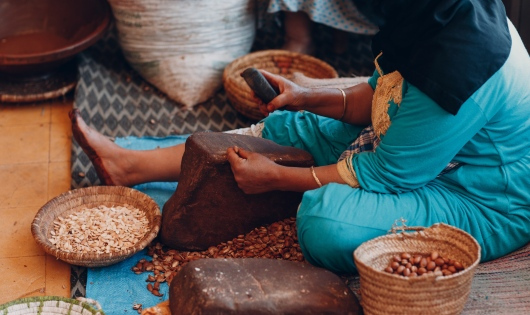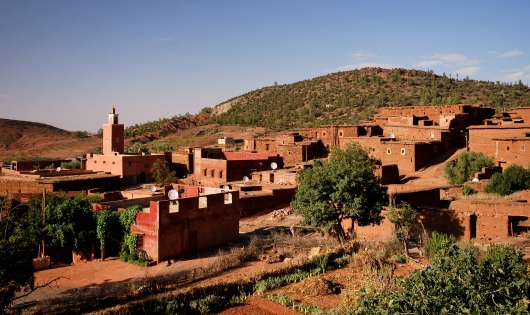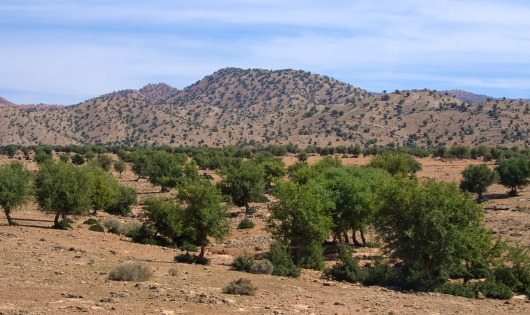Argan oil is among the most expensive oils in the world. The reason: The Argan tree, Argania spinosa, only grows in Morocco and Algeria. The oil comes from the ripe berries, which are pressed. The worldwide boom of Argan oil is, among other things, thanks to the United Nations, which declared the area of the Argan trees a biosphere reserve. In Morocco, Argan oil is considered a beauty product for skin and hair. It moisturizes, inhibits inflammation, and counters wrinkles. Plant-based active ingredients and a high proportion of Vitamin E result in Argan oil alleviating various skin problems. Traditionally, it is also known in Morocco as a remedy against hair loss and joint pain.
The unique composition of fatty acids in argan oil is particularly beneficial for dry skin. Oleic acid helps to transport the plant-based active ingredients of the oil deep into the skin. There, linoleic acid supports the function of the sebaceous glands to produce sebum for the skin. Sebum - also known as skin fat - coats the skin with a natural protective layer that eliminates all types of pathogens. Linoleic acid is also an important component of cell membranes. Only if these membranes are elastic can the cells in the skin perform their function well and renew themselves regularly. In addition, linoleic acid has the property of retaining moisture in the skin. On the one hand, linoleic acid increases the skin's moisture content, and on the other hand, it also reduces water loss.
Especially in women during and after menopause, reduced estrogen production leads to increased loss of moisture and thus to dry, wrinkled skin. At the same time, numerous active ingredients in argan oil stimulate collagen production. The structural protein collagen is the most important component of connective tissue and skin. A lack of collagen can be a reason why you suffer from dry skin. Argan oil contains a lot of coenzyme Q10, melatonin, and ferulic acid. These substances promote the production of collagen. The skin can best absorb argan oil when it is slightly moist. Directly after showering is the ideal opportunity to massage argan oil into the still slightly damp skin. Alternatively, you can spray your skin with a little water.
Most women suffer more or less severely from cellulite. The reason is the structure of the female connective tissue. In men, the fibers run in all possible directions and are thus strengthened by bracing. In women, however, they are arranged parallel and can easily be stretched by fat cells. The storage of fat causes the dimples of cellulite to form. At the same time, cellulite leads to the spaces between the fat cells no longer being so well supplied with blood. The fatty acids of argan oil resemble human skin and absorb well. They can penetrate into deep layers of skin. There, the numerous antioxidants of argan oil unfold their positive effect. Linoleic acid, for example, allows more moisture to be bound in the tissue.
This acts like a cushion for the spaces between the fat cells. At the same time, coenzyme Q10, melatonin, and squalene enhance the circulation of the skin in the deeper layers. In addition, the procyanidins, epigallocatechin gallate, and epicatechin tighten the skin – these substances are also found in green tea and are responsible for its skin-tightening effect. Argan oil is particularly effective for cellulite when you use it in combination with a brush massage. Since a brush massage is stimulating, the morning is the right time for it. Stroke over affected skin areas towards the heart for five to ten minutes. Then take a shower – ideally a shower alternating between hot and cold. Massage the argan oil into your still damp skin after the shower.
Argan oil can improve the symptoms of numerous skin diseases. A main reason for this is the fact that argan oil improves the skin's moisture content. This reduces, for example, the number of itchy scales in psoriasis, the widespread plaque psoriasis. This effect is also important in eczema, which often occurs with dry skin. In addition, argan oil promotes and regulates the circulation and production of sebum in the skin. The skin fat not only keeps the skin supple, but it also acts as a natural barrier against all kinds of pathogens. The antibacterial effect of argan oil also extends to Propionibacterium acnes, the cause of acne.
Thanks to vitamin E and numerous plant-based active ingredients, the strongly antioxidative effect of argan oil helps skin impurities to heal quickly. Furthermore, argan oil is a non-comedogenic plant oil. This means it does not clog the skin pores and therefore does not lead to the formation of comedones (blackheads). In case of skin diseases, you can make a mild shower gel with argan oil yourself. For this, dissolve 50 grams of grated core soap in 200 ml of hot distilled water. Now mix the soap solution with 30 ml of argan oil. A few drops of essential oil provide fragrance. Rose and lavender oil are ideal for this. In addition, you can take care of your skin daily with argan oil. The oil is best absorbed if you massage it into slightly moist skin – for example, after a shower.
The wealth of natural active ingredients in argan oil is excellent for the care of hair and eyelashes. A scalp massage with argan oil allows the healthy fatty acids and antioxidants such as vitamin E to penetrate deep into the scalp and reach the hair roots. In this way, the oil promotes hair growth and regulates sebum production. It's best to let the oil work for a few hours after a massage before you wash your hair with a mild shampoo. You can also use argan oil to care for brittle and split ends. For this, rub three drops of argan oil with your fingertips and run them over the hair tips.
You can easily make a hair cure yourself. For this, mix an egg yolk with four tablespoons of argan oil, four tablespoons of yogurt, and a splash of lemon juice. Massage the hair cure well into the hair. Then wrap your head with cling film and cover it with a towel. The hair cure should work for at least half an hour before you wash your hair with shampoo. For eyelash care, it's easiest to apply argan oil with a mascara brush that you have thoroughly washed with hot water. The perfect time is in the evening before going to bed. This way, the oil can work overnight. After about four weeks of daily care, the first positive effects should become visible.
Argan oil is excellent as a massage oil. Thanks to its iodine value of 95 to 105, it absorbs well into the skin and leaves no greasy film. The iodine value indicates how many grams of iodine 100 grams of oil can dissolve. The higher this number, the better the oil can penetrate the skin. The spread value of argan oil is in the medium range. This means it spreads well without absorbing too quickly into the skin. Also, it feels pleasantly smooth on the skin. You can use pure argan oil as a massage oil without any problems. But you can also mix it with other oils to supplement the properties of argan oil. Jojoba oil, for example, enhances the antibacterial and antifungal effect of argan oil.
However, the feel of jojoba oil is not ideal. Therefore, we recommend the following mixing ratio: half argan oil, a quarter jojoba oil, and a quarter cocoa butter or avocado oil. With essential oils, you can give argan oil any desired fragrance note. In principle, any pure natural essential oil is suitable. What is allowed is what pleases. In general, we find combinations of head, heart, and base notes particularly pleasant. Citrus scents and conifers belong to the head notes, flowers like rose and lavender to the heart notes, and heavy woods like cedar and vanilla to the base notes. The amount should not exceed 25 drops per 100 ml.
The effect of argan oil on hyperpigmentation is well-documented scientifically. Argan oil influences melanin production through complex processes at the cellular level. The pigment melanin determines the color of the skin, eyes, and hair. Melanocytes in the skin produce this pigment from the protein tyrosine through biochemical reactions. It protects the skin from the harmful effects of ultraviolet rays and from oxidative stress caused by environmental influences.
If the body produces too much melanin, age spots and freckles occur. Pigmentation disorders during pregnancy and skin cancer are also the result of excessive melanin production.
Argan oil inhibits the production of melanin by activating a protein, the MITF transcription factor. This protein ensures that the enzymes necessary for melanin production cannot function properly. A study showed that argan oil renders two of the three enzymes involved ineffective by connecting molecules with them. Scientists suspect that the high content of vitamin E in argan oil is responsible for this, among other things. Furthermore, this effect is attributed to the synergy of the plant substances in argan oil.
The effect of argan oil on melanin production occurs relatively quickly. Just 48 hours after applying the oil, the skin produces significantly less melanin. After 72 hours, the effect is greatest. Argan oil can not only counteract pigmentation disorders. At the same time, it also replaces the antioxidant effect of melanin with its high proportion of vitamin E and other antioxidants.
The natural ingredients of argan oil promote wound healing through various mechanisms. Among other things, the composition of the fatty acids accelerates the healing of wounds. Argan oil is largely made up of linoleic acid and oleic acid. Both fatty acids strengthen the immune defense in wounds by increasing the number of white blood cells in the wound area. At the same time, they reduce the number of dead cells at the wound edges.
In addition, argan oil increases the transforming growth factor TGF-β in wounds. This signaling molecule promotes the formation of new cells and ensures that wounds close faster.
In addition, the numerous antioxidants in argan oil eliminate free radicals, which are produced by bacteria and delay wound healing. The high proportion of vitamin E promotes the healing process additionally, although the underlying mechanisms are currently unclear.
Considerable amounts of coenzyme Q10 and melatonin in argan oil also improve wound healing. Both substances strengthen the mitochondria, the energy suppliers of cells. In addition, melatonin activates enzymes that have an anti-inflammatory effect and stimulate the formation of new blood vessels and collagen.
Also, the numerous polyphenols in argan oil support the healing process of the skin. For example, procyanidins enhance the effect of vitamin E. Epigallocatechin gallate, which is also commonly found in green tea, inhibits inflammation via the Notch signaling pathway. This signaling pathway causes cells to take into account the information of surrounding cells in their activities.
For centuries, the Berber women of Morocco have used argan oil for skincare. Argan oil not only helps to infuse moisture into the skin but also regulates the production of sebum, which is increased in oily skin. Excessive sebum production is one of the main causes of acne and skin impurities.
Studies support these effects. However, scientists do not yet fully understand what this effect of argan oil is based on. One reason for the fat-regulating effect of argan oil could be its high content of linoleic acid. From this fatty acid, the body can produce wax esters and ceramides, which are present in the stratum corneum of the skin. These ensure that the natural skin barrier functions well. When the skin is well protected, the sebaceous glands can reduce their production. In addition, oleic acid helps to strengthen the skin's defenses. Also, oleic acid can penetrate deeply into the skin and improve the moisture content of the dermis (middle layer of skin).
Another reason for the balancing effect of argan oil on the skin's sebum production could be the unique combination of antioxidants. In addition to plenty of vitamin E, argan oil provides a large amount of the antioxidants found in green tea, including epigallocatechin gallate and epicatechin. Cosmetics with green tea have been proven to regulate the skin's fat content.
The Berber women use argan oil to balance the effects of Morocco's strong sun. Several studies now show that argan oil improves the elasticity of women's skin after menopause. Additionally, argan oil increases the skin's ability to retain moisture. This softens the skin and leads to a relaxed appearance. Furthermore, argan oil counters age spots that arise from the accumulation of skin pigments. With increasing age, the skin has fewer melanocytes, the cells that produce the skin pigment melanin. However, the remaining melanocytes are very large and unevenly distributed.
Scientists attribute the positive effect of argan oil on wrinkles and other signs of skin aging to the composition of unsaturated fatty acids. Linoleic acid strengthens the skin because sebaceous glands can convert it into wax esters and ceramides. In addition, it helps retain moisture in the upper layer of the skin. On the other hand, oleic acid in argan oil allows active ingredients to penetrate into the middle layer of skin (dermis). There, the numerous antioxidants of argan oil can exert their effect.
Thus, the high content of vitamin E protects the skin from damage by UV rays. The effects of coenzyme Q10 and melatonin against skin aging are proven by several scientific studies. Both substances promote the formation of collagen in the skin. This protein is present in all connective tissues of the human body and gives the skin its elasticity. The antioxidant squalene further improves the skin's appearance.
In Morocco, argan oil has been used as a universal beauty remedy for centuries. It strengthens brittle nails and improves hair growth. Moroccan men even use argan oil to combat hair loss.
So far, the positive effect of argan oil on hair, eyelashes, and nails has been insufficiently researched scientifically. However, it is proven that argan oil rebuilds hair stressed by dyeing.
Its unique combination of healthy fatty acids with numerous antioxidants such as vitamin E and melatonin, however, explains the strengthening effect on hair, eyelashes, and nails. Vitamin E and melatonin stimulate hair growth. Argan oil is particularly effective on eyelashes, as their roots are not as deep under the skin as those of head hair.
Oleic acid causes the plant substances of argan oil to penetrate deeply into the scalp and also reach the roots of eyelashes. Linoleic acid helps build the wax esters and ceramides that are important for healthy hair. These substances are found in hair and are often dissolved during hair care. Linoleic acid also plays a vital role in healthy nails. A lack of linoleic acid causes nails to become brittle.
In addition, argan oil provides a substantial amount of squalene. This antioxidant is also a component of healthy hair. Squalene has long been incorporated into numerous hair products and other cosmetics for skin and nails because it helps repair hair damage. It also promotes circulation to the hair roots and nail bed, and thus the supply of nutrients, in conjunction with other antioxidants in argan oil.
Ysamin argan oil meets the highest standards of quality. The Moroccan Ministry of Agriculture monitors the organic certificate of Ysamin argan oil. Numerous Berber women earn their livelihood and secure their independence by producing Ysamin argan oil. They collect the nuts and free them from their hard shells using stones. Re-sorting after shelling ensures that only absolutely dry nuts are used for the oil, so it remains long-lasting. To guarantee the highest quality, the pressing process deviates from tradition. The nuts are not ground before pressing, as friction heat would damage the ingredients. A modern hydraulic press provides golden yellow oil through cold pressing. Ysamin argan oil has a fine nutty smell and is intended exclusively for cosmetic use.

The history of argan oil begins with the Phoenicians. As early as 1550 BC, these seafarers and traders used the oil for beauty care.

For many centuries, argan oil has been an important product of the Berber people based in Morocco. The women of the Berber tribes became experts in the production of the oil, which they used for skin and hair care, as well as in the kitchen.
Originally, goats helped to harvest the nuts from the thorny trees. The goats climb the argan trees and consume the fruits, which are then excreted and further processed.

At the end of the millennium, there was a risk that the argan trees would become extinct. Many trees were cut down to grow oranges, tomatoes, and other fruits. Moroccan professor Zoubida Charrouf made a significant contribution to today's argan oil boom.
As early as 1996, she founded cooperatives so that women could continue to benefit from the production of argan oil. Moreover, her commitment led to the properties of the oil being scientifically investigated.

The United Nations also helped preserve the argan trees. In 1998, they declared an 800,000-hectare area in the foothills of the Atlas Mountains in southwestern Morocco as the Arganeraie Biosphere Reserve. In 2014, the United Nations recognized the traditional knowledge about argan oil as intangible cultural heritage. The argan tree is the only representative of the genus Argania, which belongs to the family of sapotaceous (Sapotaceae). It is one of the oldest tree species in the world. The trees were already growing in Morocco during the Tertiary period, about 80 million years ago.